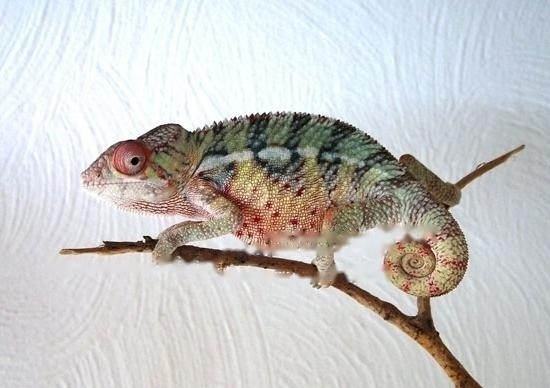The chameleon is a very unique reptile, he is not like other reptile species that can be described in one piece, and his feeding method is not like the general reptiles. There seems to be a general rule to follow, if you have raised it before Turtles, lizards, geckos, but when you want to start raising chameleons, you must first abandon the original reptile knowledge and feeding habits in your mind. Let’s take a look at the popular science knowledge of raising chameleons with the editor. Bar.

1. Appropriate temperature
The most suitable temperature range for raising high crowns is 25~ 32 degrees, many friends only think that the hot spot is 32~35 degrees. In fact, when the hot spot is very different from the room temperature, the temperature drops rapidly from the spotlight to the bottom of the box. For example, when the room temperature is lower than ~15 degrees, it may be very high under the spotlights, but the spotlights cannot raise the temperature of the entire rearing box to an appropriate temperature (25~28 degrees), and the temperature at the bottom of the box or other locations may still be very low. And the chameleon will not stay in the hot spot for 24 hours. When it leaves the hot spot, it is equivalent to living in a low temperature. This is why many friends think that the temperature is high enough and still find that the chameleon has a cold, indigestion, loss of appetite, etc. Symptoms appear! This problem is especially obvious in well-ventilated and large breeding boxes, so everyone must be aware of the temperature anywhere in the breeding box, and ensure that the temperature in the entire breeding box does not drop below 25 degrees.
There is no guideline for the wattage of the spotlights used. It mainly depends on the size of the rearing box and the room temperature. Use a thermometer to measure the temperature to determine what wattage bulb to use. Also keep in mind that in any case, the spotlight and the chameleon must be kept at a distance, otherwise it will burn.
Symptoms or problems of hypothermia: darkening of color, loss of appetite, indigestion, respiratory infection (cold), etc.
2. Appropriate humidity
Many people think that high humidity must be high to raise high crowns. Generally, ultrasonic atomization is used to increase humidity, but it must be remembered Use a timer switch to control, long-term use of atomization will make the breeding box too wet, which is easy to breed bacteria. In fact, the high crown does not require high humidity, about 50% during the day and about 70% at night. In the south, except for a dry bath in winter (in fact, as long as you spray more water), you don't need to atomize at all.
Note that larvae need high humidity (about 70~90%), and the rearing box must use moisturizing substrates such as soil, grass moss (do not use bark), a variety of plants and water can also be used Increase humidity, but care must be taken to avoid bacterial growth.
High or low humidity can also cause problems with chameleon peeling. If the old skin cannot be peeled off, it is easy to breed fungi, which may cause skin diseases (calluses or inflammation on the body). The nail or tail tip will fall off because the old skin is tied up and hinder the delivery of nutrients. After the nail or tail tip falls off, there will be wounds. If the wound is not treated, it is easy to become inflamed.
Also note that the humidity will drop after using the heating lamp. In winter, because the temperature and humidity are also low, most people will use the heating lamp, the humidity will become extremely low, the eyes and trachea will be dry, easy to Cause eye diseases or colds, so in addition to considering the temperature in winter, you must also pay attention to maintaining proper humidity.
Symptoms or problems: poor peeling, respiratory disease, eye disease, easy breeding of bacteria in the breeding box, etc.
![[Dog Training 5] The training method of pet dog dining etiquette](/static/img/12192/12192_1.jpg)




